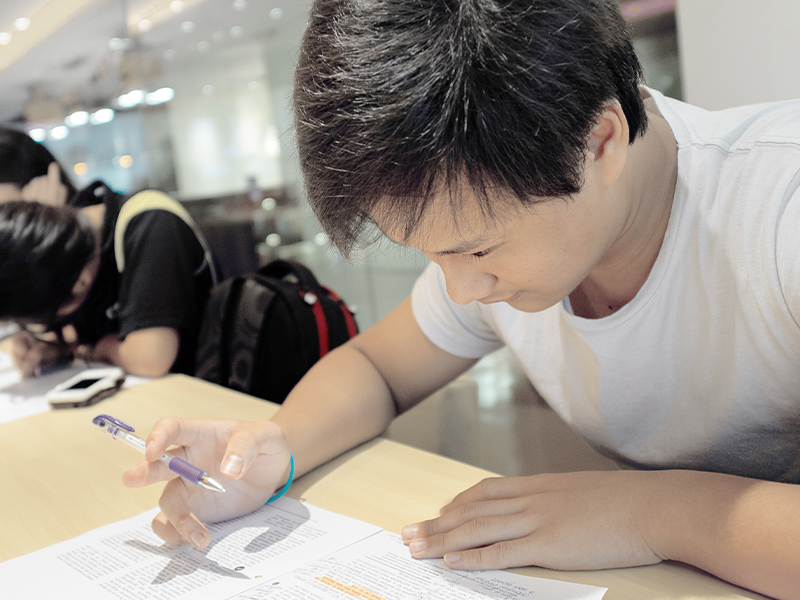There is a lot of preparation involved leading up to the exam day. Though your young learner may feel ready for the big day, he or she may still make some of the classic mistakes students make when sitting for their exams.
We explore these mistakes, and the strategies you can use to help your child avoid them and how your child can develop problem-solving skills in the process.

Besides the stress of remembering large amounts of information, students often feel anxious about being able to complete the papers within the given time limit. As a result, they rush through the exam questions without reading them properly, setting them back from truly understanding what is required in their answers.
Remind your child that exams are not a race. Rushing through the paper can lead to poor results. It is important that your child reads each question carefully.
It is also helpful to support your child’s emotional process. Students who panic during an exam experience feelings of distress, fright, nervousness and agitation.
One useful technique that your child can use to alleviate stress when he or she feels panic-stricken during a paper is to take deep, slow and long breaths.
The American Institute of Stress notes that “deep breathing increases the supply of oxygen to your brain and stimulates the parasympathetic nervous system, which promotes a state of calmness.”

In the same way as rushing through questions can hurt your child's test performance, giving too much thought to each question can be just as ineffective. This is especially true if your child begins feeling demoralised about not being able to get the correct answer.
Remind your child to use his or her exam time effectively and practise timekeeping.
For example, if your child is given an hour and 10 minutes (70 minutes in total) for situational writing and continuous writing, he or she can allocate roughly 25 minutes for the situational writing section and 35 minutes for the continuous writing section. This still leaves him or her 10 minutes to review both of the pieces before the time is up.
For other types of examinations, like comprehension, Maths and Science, if your child is really struggling with a question, try suggesting to skip that question and return to explore it later, when the rest of the paper is completed.

Multiple-choice questions are designed to trick the mind and test a student’s comprehension.
It is not uncommon for panicky students to leave multiple-choice questions blank when they are unsure of the answer. Although they intend to return to those questions, they do occasionally forget or run out of time to do so.
Your child should read each question thoroughly and not just skim through for the keywords.
Another strategy you can teach your child is to answer the question in his or her mind first and then read all the choices before hurriedly indicating an answer. This will help in eliminating all the wrong choices before your child ticks what is perceived to be the right one.
Another trick is to pay attention to the words “not”, “never”, “sometimes”, “usually”, “often” and “always”. These qualifiers alter the statement — choose the one that makes most logical sense.
If your child is stuck and does not know the correct answer, it is best to select the item that “feels” right, thus making an educated guess rather than leaving the item blank altogether.

Easier questions can sometimes provide clues to the harder ones, but students tend to prefer to answer the easier questions last.
This is not advisable especially if the student does not have good time management.
It is best to prioritise exam questions that your child knows the answers to. Going back to more challenging questions once all the other answers have been filled in is a smarter way to get better exam results. Your child will then be able to take his or her time with answering the challenging questions.

Students tend to jump straight into writing a composition without planning out the sequence of events within the narrative.
When this happens, the whole composition becomes confusing and sometimes even incomprehensible.
Get your child into the habit of creating an outline for his or her composition.
At The Learning Lab, we delve into the finer details of composition planning by teaching our students how to plan a story, generate ideas and structure the flow by drafting out a story curve.
A story curve (sometimes also referred to as a story arc) is a typical structure that can be applied to narrative stories. It helps your child visualise the five components that make up a good composition: the introduction, rising action, climax, falling action and conclusion.
The story curve allows your child to plan his or her composition in a chronological manner and ensures that he or she will not miss out on any important parts of the story.
Click here for a P3 & P4 guide or here for a P5 & P6 guide on how your child can structure a story curve to achieve an impressive composition.
If there is enough time, a rough draft would also be helpful in fine-tuning his or her ideas, ensuring that your child does not go off-topic or hop on to irrelevant points.
If there is not enough time to write a draft before the final composition, at least advise your young learner to ask the following questions:
Does this sound captivating?
Is this factual? Can this be supported by evidence?
Can I make this statement shorter and clearer?
Is the transition between sentences and/or paragraphs smooth?
Have I captured and illustrated the main points?

By helping your child beat exam stress, you are setting him or her up for better test results and a more joyful experience during an academically demanding period.
The academic experts at The Learning Lab have put together an SA2 revision guide for your child, drawing on current trends of the common mistakes that students make for each subject, and how your child can learn from these mistakes.
This revision guide features common mistakes and challenges in English, Maths and Science and our corresponding tips for answer precision with relevant examples for each subject.
Download and print a copy of this complimentary SA2 Revision Guide for your child.
The Learning Lab is now at 8 locations. Find a location that suits your needs.
If you have any questions about our programmes, please email us at enquiry@thelearninglab.com.sg or call us at 6733 8711 and we will be happy to assist you.